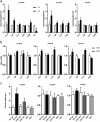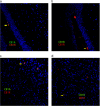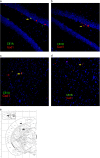Identification of novel mouse and rat CB1R isoforms and in silico modeling of human CB1R for peripheral cannabinoid therapeutics
- PMID: 30202012
- PMCID: PMC6460360
- DOI: 10.1038/s41401-018-0152-1
Identification of novel mouse and rat CB1R isoforms and in silico modeling of human CB1R for peripheral cannabinoid therapeutics
Abstract
Targeting peripheral CB1R is desirable for the treatment of metabolic syndromes without adverse neuropsychiatric effects. We previously reported a human hCB1b isoform that is selectively enriched in pancreatic beta-cells and hepatocytes, providing a potential peripheral therapeutic hCB1R target. It is unknown whether there are peripherally enriched mouse and rat CB1R (mCB1 and rCB1, respectively) isoforms. In this study, we found no evidence of peripherally enriched rodent CB1 isoforms; however, some mCB1R isoforms are absent in peripheral tissues. We show that the mouse Cnr1 gene contains six exons that are transcribed from a single promoter. We found that mCB1A is a spliced variant of extended exon 1 and protein-coding exon 6; mCB1B is a novel spliced variant containing unspliced exon 1, intron 1, and exon 2, which is then spliced to exon 6; and mCB1C is a spliced variant including all 6 exons. Using RNAscope in situ hybridization, we show that the isoforms mCB1A and mCB1B are expressed at a cellular level and colocalized in GABAergic neurons in the hippocampus and cortex. RT-qPCR reveals that mCB1A and mCB1B are enriched in the brain, while mCB1B is not expressed in the pancreas or the liver. Rat rCB1R isoforms are differentially expressed in primary cultured neurons, astrocytes, and microglia. We also investigated modulation of Cnr1 expression by insulin in vivo and carried out in silico modeling of CB1R with JD5037, a peripherally restricted CB1R inverse agonist, using the published crystal structure of hCB1R. The results provide models for future CB1R peripheral targeting.
Keywords: alternative splicing; cannabinoids; cell- and tissue-based therapy; gene expression.
Conflict of interest statement
The authors declare no competing interests.
Figures







Similar articles
-
Discovery and characterization of two novel CB1 receptor splice variants with modified N-termini in mouse.J Neurochem. 2017 Aug;142(4):521-533. doi: 10.1111/jnc.14099. Epub 2017 Jul 18. J Neurochem. 2017. PMID: 28608535 Free PMC article.
-
Low Basal CB2R in Dopamine Neurons and Microglia Influences Cannabinoid Tetrad Effects.Int J Mol Sci. 2020 Dec 21;21(24):9763. doi: 10.3390/ijms21249763. Int J Mol Sci. 2020. PMID: 33371336 Free PMC article.
-
Molecular-interaction and signaling profiles of AM3677, a novel covalent agonist selective for the cannabinoid 1 receptor.ACS Chem Neurosci. 2015 Aug 19;6(8):1400-10. doi: 10.1021/acschemneuro.5b00090. Epub 2015 May 29. ACS Chem Neurosci. 2015. PMID: 25978068 Free PMC article.
-
The therapeutic potential of second and third generation CB1R antagonists.Pharmacol Ther. 2020 Apr;208:107477. doi: 10.1016/j.pharmthera.2020.107477. Epub 2020 Jan 9. Pharmacol Ther. 2020. PMID: 31926199 Free PMC article. Review.
-
Peripheral CB1R as a modulator of metabolic inflammation.FASEB J. 2021 Apr;35(4):e21232. doi: 10.1096/fj.202001960R. FASEB J. 2021. PMID: 33715173 Review.
Cited by
-
Dissecting the role of CB1 and CB2 receptors in cannabinoid reward versus aversion using transgenic CB1- and CB2-knockout mice.Eur Neuropsychopharmacol. 2021 Feb;43:38-51. doi: 10.1016/j.euroneuro.2020.11.019. Epub 2020 Dec 15. Eur Neuropsychopharmacol. 2021. PMID: 33334652 Free PMC article.
-
Cannabis, cannabinoid receptors, and endocannabinoid system: yesterday, today, and tomorrow.Acta Pharmacol Sin. 2019 Mar;40(3):297-299. doi: 10.1038/s41401-019-0210-3. Epub 2019 Jan 22. Acta Pharmacol Sin. 2019. PMID: 30670816 Free PMC article. No abstract available.
-
Fyn kinase mediates pro-inflammatory response in a mouse model of endotoxemia: Relevance to translational research.Eur J Pharmacol. 2020 Aug 15;881:173259. doi: 10.1016/j.ejphar.2020.173259. Epub 2020 Jun 18. Eur J Pharmacol. 2020. PMID: 32565338 Free PMC article.
-
Anti-Inflammatory and Pro-Autophagy Effects of the Cannabinoid Receptor CB2R: Possibility of Modulation in Type 1 Diabetes.Front Pharmacol. 2022 Jan 18;12:809965. doi: 10.3389/fphar.2021.809965. eCollection 2021. Front Pharmacol. 2022. PMID: 35115945 Free PMC article. Review.
-
Cannabidiol (CBD) in Cancer Management.Cancers (Basel). 2022 Feb 10;14(4):885. doi: 10.3390/cancers14040885. Cancers (Basel). 2022. PMID: 35205633 Free PMC article. Review.
References
MeSH terms
Substances
Grants and funding
LinkOut - more resources
Full Text Sources
Other Literature Sources
Molecular Biology Databases

